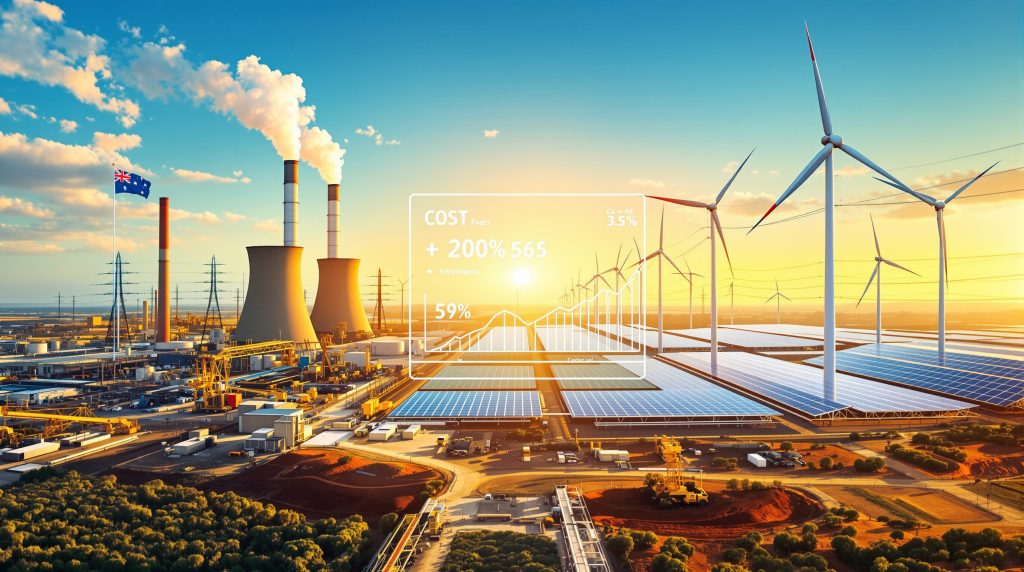Queensland's New Energy Roadmap: Balancing Reliability with Transition
Queensland's Energy Roadmap represents a significant policy shift in Australia's energy landscape, prioritizing affordability and reliability while maintaining a commitment to renewable energy growth. Released in October 2025, this strategic framework replaces the previous Labor administration's Energy and Jobs Plan with a more pragmatic approach to energy transition.
The roadmap establishes a balanced pathway that extends the operational life of Queensland's coal-fired power stations while simultaneously investing in renewable energy infrastructure and storage solutions. This dual-track strategy aims to ensure energy security while gradually increasing the state's renewable energy capacity.
How Does the New Roadmap Differ from Previous Plans?
Abandoning Fixed Coal Plant Closure Timelines
The most notable change in Queensland's energy strategy is the elimination of the previous government's 2035 deadline for coal plant closures. Treasurer and Energy Minister David Janetzki described the former plan as "ideological" and "undeliverable," emphasizing that the new approach is "based on economics and engineering, not ideology."
Under the revised roadmap, Queensland's coal-fired power stations—among the youngest in Australia—will continue operating as long as they remain economically viable and necessary for system stability. This marks a fundamental shift from time-based decommissioning to market-driven retirement.
Economic Benefits and Cost Projections
The government projects substantial economic benefits from this revised approach:
- An estimated A$26 billion in energy system cost savings through 2035
- Average household savings of A$1,035 annually compared to the previous plan
- Improved investment certainty for both conventional and renewable energy sectors
These projections reflect the government's focus on minimizing economic disruption during the energy transition while maintaining reliable power supply.
What Are the Key Investment Components?
Financial Commitments and Infrastructure Development
The roadmap includes several major funding initiatives to support Queensland's energy future:
- A$400 million Queensland Energy Investment Fund to attract private capital for new generation and energy storage projects
- A$1.6 billion Electricity Maintenance Guarantee for upgrading and maintaining existing power assets
- Tender for 400 MW of new gas-fired generation capacity in Central Queensland
- A$10 million allocation for community-level battery projects
These investments aim to create a more resilient and diverse energy system while supporting regional economic development.
Transmission and Storage Projects
The plan advances several critical transmission and storage projects:
- Consolidation of pumped hydro development under the Queensland Investment Corporation
- Acceleration of the CopperString transmission project, including both Eastern and Western links
- Enhanced connectivity between North and North West Queensland's energy networks
These infrastructure improvements are designed to support the integration of renewable energy while maintaining system reliability.
What Role Will Fossil Fuels Play in Queensland's Energy Future?
Extended Lifespan for Coal Assets
Under the new roadmap, Queensland's coal-fired power stations will remain operational significantly longer than previously planned. This extension acknowledges the critical role these facilities play in providing baseload power and system stability.
The government emphasizes that these plants will continue operating "for as long as they are needed in the system and supported by the market," rather than adhering to an arbitrary closure timeline.
Gas as a Transition Fuel
The roadmap recognizes natural gas as an essential component of Queensland's energy transition, particularly for its ability to provide rapid response generation when renewable output fluctuates. The planned 400 MW gas-fired generation project in Central Queensland reflects this commitment to maintaining dispatchable power capacity.
Industry stakeholders, including the Queensland Resources Council, have highlighted concerns about potential gas shortfalls in coming decades and stressed the need for new projects or expansions to meet future demand.
How Will Renewable Energy Development Progress?
Renewable Energy Zones and Targets
Despite the extended timeline for fossil fuel generation, Queensland maintains its commitment to renewable energy expansion through:
- Continued development of Renewable Energy Zones (REZs) to coordinate wind and solar project deployment
- Targeting 50% renewable energy by 2030, increasing to 80% by 2035
- Focusing 95% of new renewable investment in regional Queensland to support economic development
These targets demonstrate Queensland's ongoing commitment to renewable energy growth while acknowledging the need for a measured transition.
Private Sector Partnerships
The roadmap emphasizes collaboration between government-owned corporations and private investors to accelerate renewable energy development. This partnership approach aims to leverage private capital while maintaining public oversight of critical energy infrastructure.
The A$400 million Queensland Energy Investment Fund specifically targets private sector participation in new generation and firming capacity projects, creating a framework for shared investment in the state's energy future.
What Environmental Considerations Are Addressed?
Emissions Reduction Challenges
The extended operation of coal-fired power stations creates tension with Queensland's emissions reduction targets. The state has committed to a 75% reduction in emissions by 2035, which environmental groups argue will be difficult to achieve under the new roadmap.
Critics suggest that prolonging coal generation and expanding gas infrastructure could undermine these climate commitments and potentially impact sensitive ecosystems like the Great Barrier Reef.
Balancing Environmental and Economic Priorities
The government frames the roadmap as a realistic approach that balances environmental objectives with economic necessities. By maintaining existing generation while investing in renewables, Queensland aims to achieve a gradual transition that minimizes economic disruption while still progressing toward a lower-carbon future.
This approach reflects the complex trade-offs involved in energy policy, particularly in regions with significant fossil fuel resources and industries.
What Are the Critical Minerals Opportunities?
CopperString and North West Minerals Province
A significant element of the roadmap is its support for the CopperString transmission project, which could unlock an estimated A$500 billion in critical minerals energy transition reserves in Queensland's north-west region.
The Queensland Resources Council has emphasized the importance of the Western Link from Hughenden to Mt Isa as "essential for exploration and production of the critical minerals needed for the energy transition." This connection between energy infrastructure and mineral development highlights the integrated approach of the roadmap.
Addressing Project Approval Timelines
Industry stakeholders have urged the government to improve the pace of project approvals, noting that resources projects in Queensland "can take up to 16 years to get out of the ground due to duplication and excessive regulation."
Streamlining these processes will be crucial for Queensland to capitalize on growing demand for mineral exploration insights and resources essential to renewable energy technologies and battery storage.
What Has Been the Industry Response?
Resource Sector Support
The Queensland Resources Council has welcomed the roadmap, with CEO Janette Hewson praising its recognition of the "central and critical role coal and gas will play in the state's shared energy future."
Industry representatives have emphasized the importance of energy diversity and the need to ensure replacement capacity is operational before traditional generation is retired. This sequenced approach aims to maintain system reliability throughout the transition period.
Calls for Regulatory Improvement
While supportive of the roadmap's direction, industry groups have called for improvements in regulatory processes to accelerate project development. These stakeholders argue that streamlined mining permitting challenges are essential for Queensland to maximize economic opportunities in both traditional and renewable energy sectors.
Furthermore, many in the industry are advocating for the adoption of industry innovation trends to enhance productivity and sustainability across the energy and resources sectors.
What Concerns Have Environmental Groups Raised?
Climate Impact Warnings
Environmental organizations have expressed significant concerns about the roadmap's extended timeline for fossil fuel generation. Critics argue that prolonging coal and gas operations will:
- Make it difficult to achieve Queensland's 75% emissions reduction target by 2035
- Potentially jeopardize the World Heritage status of the Great Barrier Reef
- Increase climate-related risks to Queensland communities
These groups advocate for a more rapid transition to renewable energy to address climate challenges.
Economic Transition Arguments
Environmental advocates also question the economic rationale behind extending fossil fuel operations, suggesting that:
- Continued investment in aging coal plants could lead to higher maintenance costs
- Delaying the transition may result in Queensland missing opportunities in the growing renewable energy sector
- The state risks becoming less competitive as other regions accelerate their clean energy development
These perspectives highlight the ongoing debate about the optimal pace and pathway for energy transition.
How Will the Roadmap Impact Regional Communities?
Job Creation and Economic Development
The roadmap emphasizes regional economic benefits, with 95% of new renewable energy investment expected to occur in regional Queensland. This focus aims to create new employment opportunities while supporting communities currently dependent on fossil fuel industries.
The maintenance of existing coal and gas operations also provides time for workforce transition planning and skills development programs to prepare workers for emerging energy sectors.
Community-Level Energy Solutions
The A$10 million allocation for community-level batteries reflects an interest in decentralized energy solutions that can enhance local resilience and participation in the energy transition. These smaller-scale projects complement larger infrastructure investments while providing direct benefits to regional communities.
What's the Long-Term Vision for Queensland's Energy System?
Gradual Transformation Rather Than Rapid Change
Queensland's new energy roadmap envisions a measured transformation of the state's energy system, with fossil fuels playing a continuing role while renewable capacity steadily expands. This approach prioritizes system stability and affordability while working toward longer-term sustainability goals.
The roadmap positions Queensland to maintain its status as an energy powerhouse while adapting to changing technology and market conditions over time. Additionally, the plan creates opportunities for developing battery-grade lithium refinery capacity to support the growing battery storage industry.
Flexibility and Adaptability
A key principle of the roadmap is maintaining flexibility to respond to evolving circumstances rather than locking in rigid timelines. This adaptability allows Queensland to adjust its energy strategy based on technological developments, economic conditions, and changing energy needs.
Conclusion: Finding Balance in Energy Transition
Queensland's Energy Roadmap represents a pragmatic approach to the complex challenges of energy transition. By extending the operational life of existing coal assets while simultaneously investing in renewable infrastructure, the state aims to maintain reliability and affordability while progressing toward a lower-carbon future.
The roadmap has generated both support and criticism, reflecting the inherent tensions between immediate economic considerations and longer-term environmental imperatives. As implementation proceeds, Queensland's experience will provide valuable insights into the practical realities of managing energy transition in regions with significant fossil fuel resources.
The success of this approach will ultimately depend on how effectively Queensland balances reliability and affordability with the need for emissions reduction and environmental protection—a challenge facing energy systems worldwide.
Further Exploration
Readers interested in learning more about Queensland's energy policies can also explore related educational content from the Queensland Government's Energy Roadmap or review the Queensland Resources Council's analysis of how the plan will impact the state's future energy security.
Ready to Spot the Next Major Mineral Discovery?
Discover why significant mineral finds can lead to exceptional market returns by exploring Discovery Alert's dedicated discoveries page, where their proprietary Discovery IQ model transforms complex ASX announcements into actionable investment opportunities before the broader market recognises their potential.




